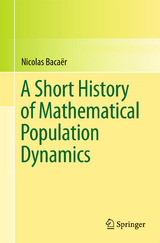A Short History of Mathematical Population Dynamics
Springer London Ltd (Verlag)
978-0-85729-114-1 (ISBN)
As Eugene Wigner stressed, mathematics has proven unreasonably effective in the physical sciences and their technological applications. The role of mathematics in the biological, medical and social sciences has been much more modest but has recently grown thanks to the simulation capacity offered by modern computers.
This book traces the history of population dynamics---a theoretical subject closely connected to genetics, ecology, epidemiology and demography---where mathematics has brought significant insights. It presents an overview of the genesis of several important themes: exponential growth, from Euler and Malthus to the Chinese one-child policy; the development of stochastic models, from Mendel's laws and the question of extinction of family names to percolation theory for the spread of epidemics, and chaotic populations, where determinism and randomness intertwine.
The reader of this book will see, from a different perspective, the problems that scientists face when governments ask for reliable predictions to help control epidemics (AIDS, SARS, swine flu), manage renewable resources (fishing quotas, spread of genetically modified organisms) or anticipate demographic evolutions such as aging.
The Fibonacci sequence (1202).- Halley’s life table (1693).- Euler and the geometric growth of populations (1748–1761).- Daniel Bernoulli, d’Alembert and the inoculation of smallpox (1760).- Malthus and the obstacles to geometric growth (1798).- Verhulst and the logistic equation (1838).- Bienaymé, Cournot and the extinction of family names (1845–1847).- Mendel and heredity (1865).- Galton, Watson and the extinction problem (1873–1875).- Lotka and stable population theory (1907–1911).- The Hardy–Weinberg law (1908).- Ross and malaria (1911).- Lotka, Volterra and the predator–prey system (1920–1926).- Fisher and natural selection (1922).- Yule and evolution (1924).- McKendrick and Kermack on epidemic modelling (1926–1927).- Haldane and mutations (1927).- Erlang and Steffensen on the extinction problem (1929–1933).- Wright and random genetic drift (1931).- The diffusion of genes (1937).- 21 The Leslie matrix (1945).- 22 Percolation and epidemics (1957).- 23 Game theory and evolution (1973).- 24 Chaotic populations (1974).- 25 China’s one-child policy (1980).- 26 Some contemporary problems.
| Zusatzinfo | 60 Illustrations, black and white; X, 160 p. 60 illus. |
|---|---|
| Verlagsort | England |
| Sprache | englisch |
| Maße | 155 x 235 mm |
| Themenwelt | Sachbuch/Ratgeber ► Natur / Technik |
| Mathematik / Informatik ► Mathematik ► Allgemeines / Lexika | |
| Mathematik / Informatik ► Mathematik ► Algebra | |
| Mathematik / Informatik ► Mathematik ► Angewandte Mathematik | |
| Mathematik / Informatik ► Mathematik ► Geschichte der Mathematik | |
| Mathematik / Informatik ► Mathematik ► Mathematische Spiele und Unterhaltung | |
| ISBN-10 | 0-85729-114-9 / 0857291149 |
| ISBN-13 | 978-0-85729-114-1 / 9780857291141 |
| Zustand | Neuware |
| Haben Sie eine Frage zum Produkt? |
aus dem Bereich




